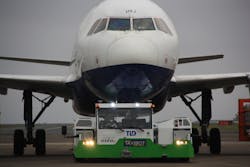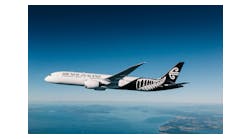We got a first-hand look at the Taxibot towing system during a special demonstration put on for the media on the Monday before Thanksgiving at Chateauroux Airport.
“Someday you can say you were a passenger of the very first jet towed by a Taxibot,” said Ran Braier, Taxibot project director for the Israel Aerospace Industries Ltd., as we sat inside an A320 with the pilot firmly at the controls of both the plane and the Taxibot underneath.
Yes, you heard that right. The pilot controls the speed of the Taxibot and essentially steers the vehicle with his tiller during towing procedures that, ideally, take the plane all the way to the runway without any power wasted from the plane’s engines.
There are a few characteristics that make the Taxibot a very different way to tow an airplane:
Pilot-controlled: The Taxibot does, in fact, have a driver inside. But the driver’s primary role is to push back the plane from the gate. During the tow, the pilot should feel no difference between using the Taxibot and taxiing under the plane’s own power.
“Allowing the pilot to control the vehicle is the key to this system,” said Gerhard Baumgarten, director of sales and marketing for Lufthansa LEOS, during a press conference held after the demonstration.
Once the plane is in position, the Taxibot’s driver takes the vehicle back to its next stop.
Cradle And All-Wheel Drive: At first glimpse, the Taxibot looks like any other towbarless tractor. But the plane’s nose gear rests in a cradle that rocks like a pendulum and absorbs energy from stops and starts. That cradle also rotates like a turret. When the pilot makes a turn from the flight deck, the cradle turns and adjusts all four wheels of the tractor so that tractor and plane are in perfect alignment.
Towing Distance: “Since all four wheels of the Taxibot can turn correctly as needed, that allows the plane and vehicle to make larger turns during the towing,” said Fabi Anbouba, vice president of sales and service for TLD America. “And since it’s the plane that brakes itself, and not the Taxibot braking the plane, we can now protect the landing gear and tow the plane a much further distance than we could before.”
The Taxibot uses hybrid diesel electric power to transport the plane. To make the point perfectly clear during our demonstration, the A320 that took us for a ride, had its engines removed (although added ballast on each wing equaled the weight of those missing engines.)
During a briefing before the demonstration, Braier outlined the economic and environmental benefits of the Taxibot system. Conventional towing practices will cost airlines around $8.5 billion in annual fuel costs by the end of the decade. That number could be cut to less than $3 billion. Braier also estimates that reduces carbon emissions by 22 million tons.
Taxibot has been a cooperative venture among IAS; Airbus; Lufthansa LEOS; and TLD Group since 2008. Airbus and IAI are in the final process of establishing a joint venture to support the program. TLD has plans for serial production of a narrow-body version of the Taxibot. Lufthansa LEOS will be testing the Taxibot under actual daily operations of the airline’s 737 fleet next year at Frankfurt Airport.
Later that week, senior reps and test pilots from various airlines and ground companies, including Lufthansa; KLM; British Airways; China Eastern Airlines; China South Airlines; Federal Express; Air France; United Airways; WestJet Aeroport de Paris; and Swissport International, traveled to the airport to evaluate the vehicle.






